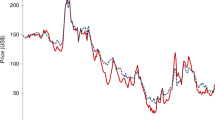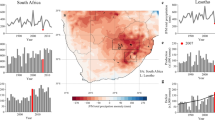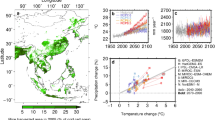Abstract
Climate change is affecting the frequency and severity of extreme weather events, such as droughts or floods, which result in loss and damage to people, crops and infrastructure. Global data on loss and damage used in research, policy and media primarily come from macrostatistics based on disaster inventories. Here, we propose a different approach, based on survey microdata. We harmonize data from 120,000 agricultural fields in six African countries for a period from 2008 to 2019 and quantify crop production losses related to climate shocks. We find substantial damages which affect around 35% of plots and reduce national crop production by 29% on average. The economic impacts are greater than the global disaster data suggest. The economic losses resulting from droughts and flood alone are US$5.1 billion higher than reported in disaster inventories, affecting between 145 and 170 million people. The difference stems mostly from smaller and less severe but frequent adverse events that go under-reported or undetected in disaster inventories and therefore elude macrostatistics and reporting. The findings have implications for measurement and policies related to loss and damage and disaster risk reduction.
This is a preview of subscription content, access via your institution
Access options
Access Nature and 54 other Nature Portfolio journals
Get Nature+, our best-value online-access subscription
$29.99 / 30 days
cancel any time
Subscribe to this journal
Receive 12 digital issues and online access to articles
$119.00 per year
only $9.92 per issue
Buy this article
- Purchase on SpringerLink
- Instant access to full article PDF
Prices may be subject to local taxes which are calculated during checkout



Similar content being viewed by others
Data availability
The raw data used in this study as well as the full questionnaires are publicly available through the World Bank online resources. LSMS-ISA datasets, questionnaires and documentation are publicly accessible through the following link: https://www.worldbank.org/en/programs/lsms/initiatives/lsms-ISA. Links to the various datasets used in this study are provided in the ‘dissemination’ tabs. More specifically, the dataset includes data from the Ethiopian Social Survey (waves 1 to 4), Malawi’s Integrated Household Panel Survey (waves 1 to 4), Mali’s Enquête Agricole de Conjoncture Intégrée (waves 1 and 2), Niger’s Enquête National sur les Conditions de Vie des Ménages et Agriculture (waves 1 and 2), Nigeria’s General Household Survey (wave 4) and Tanzania’s National Panel Survey (waves 1 to 5). The EM-DAT data were downloaded for free on the following public website: https://public.emdat.be/. Data were downloaded on 29 November 2023. The following data filters were applied—Classification: Natural; Countries: Ethiopia, Malawi, Mali, Niger, Nigeria, Tanzania; Time range: 2008–2020. The analysis dataset is available from Zenodo at https://doi.org/10.5281/zenodo.12667754 (ref. 61). Shapefiles and other raw geodata required to produce Fig. 2 were downloaded from the GADM database, which can be accessed for free at https://gadm.org/download_country.html. Population and other aggregate statistics were downloaded from the World Bank Development Indicators Database, directly into Stata using the wbopendata package. Source data are provided with this paper.
Code availability
The code for the analysis is available from Zenodo at https://doi.org/10.5281/zenodo.12667754 (ref. 61).
References
Harvey, F. Human-driven climate crisis fuelling Horn of Africa drought—study. The Guardianwww.theguardian.com/environment/2023/apr/27/human-driven-climate-crisis-fuelling-horn-of-africa-drought-study (2023).
Janjua, H. A year on, the devastating long-term effects of Pakistan’s floods are revealed. The Guardian www.theguardian.com/global-development/2023/aug/05/a-year-on-the-devastating-long-term-effects-of-pakistans-floods-are-revealed (2023).
Matonga, G. & Chutel, L. Cyclone Freddy brings mudslides and floods, leaving nearly 200 dead in Malawi. The New York Times www.nytimes.com/2023/03/14/world/africa/cyclone-freddy-malawi-mudslides-flooding.html (2023).
Otto, F. E. L. et al. Climate change increased extreme monsoon rainfall, flooding highly vulnerable communities in Pakistan. Environ. Res. Clim. 2, 025001 (2023).
Clarke, B., Otto, F., Stuart-Smith, R. & Harrington, L. Extreme weather impacts of climate change: an attribution perspective. Environ. Res. Clim. 1, 012001 (2022).
Newman, R. & Noy, I. The global costs of extreme weather that are attributable to climate change. Nat. Commun. 14, 6103 (2023).
Vaidyanathan, G. A giant fund for climate disasters will soon open. Who should be paid first? Nature www.nature.com/articles/d41586-024-00149-x (2024).
Brennan, M. E. & Danielak, S. Too small to count? The cumulative impacts and policy implications of small disasters in the Sahel. Int. J. Disaster Risk Reduct. 68, 102687 (2022).
Walecki, N. Tiny climate crises are adding up to one big disaster. The Atlantic www.theatlantic.com/science/archive/2023/11/climate-disasters-low-intensity/675864/ (2023).
Report of the Open-ended Intergovernmental Expert Working Group on Indicators and Terminology relating to Disaster Risk Reduction (UN, 2016).
Ritchie, H. Opinion | 3 charts show how better buildings save lives in earthquakes. Washington Post www.washingtonpost.com/opinions/2023/02/13/earthquake-deaths-chile-japan-turkey-compare/ (2023).
Lesk, C., Rowhani, P. & Ramankutty, N. Influence of extreme weather disasters on global crop production. Nature 529, 84–87 (2016).
Pirlea, A. F., Serajuddin, U., Wadhwa, D. & Walsh, M. (eds) Atlas of Sustainable Development Goals 2023 (World Bank, 2023).
Gall, M., Borden, K. A. & Cutter, S. L. When do losses count? Six fallacies of natural hazards loss data. Bull. Am. Meteor. Soc. 90, 799–810 (2009).
World Bank Open Data (World Bank, accessed 12 January 2024).
Poverty and Shared Prosperity 2022: Correcting Course (World Bank, 2022); https://doi.org/10.1596/978-1-4648-1893-6
Park, J., Bangalore, M., Hallegatte, S. & Sandhoefner, E. Households and heat stress: estimating the distributional consequences of climate change. Environ. Dev. Econ. 23, 349–368 (2018).
Tol, R. S. J. The economic impacts of climate change. Rev. Environ. Econ. Policy 12, 4–25 (2018).
Arslan, A., Floress, K., Lamanna, C., Lipper, L. & Rosenstock, T. S. A meta-analysis of the adoption of agricultural technology in Sub-Saharan Africa. PLoS Sustain. Transform. 1, e0000018 (2022).
Hallegatte, S., Vogt-Schilb, A., Rozenberg, J., Bangalore, M. & Beaudet, C. From poverty to disaster and back: a review of the literature. Econ. Disaster Clim. Change 4, 223–247 (2020).
Markhvida, M., Walsh, B., Hallegatte, S. & Baker, J. Quantification of disaster impacts through household well-being losses. Nat. Sustain.3, 538–547 (2020).
2023 Disasters in Numbers. A Significant Year of Disaster Impact (CRED, 2024); https://files.emdat.be/reports/2023_EMDAT_report.pdf
Song, Z., Hochman, G. & Timilsina, G. R. Natural Disaster, Infrastructure, and Income Distribution: Empirical Evidence from Global Data (World Bank, 2023); https://documents.worldbank.org/en/publication/documents-reports/documentdetail/099312406272326097/IDU018bdbef90c42104d730a46700d5b8c4c1c83
Hallegatte, S., Vogt-Schilb, A., Bangalore, M. & Rozenberg, J. Unbreakable: Building the Resilience of the Poor in the Face of Natural Disasters (World Bank, 2016).
Philippon, N., Mougin, E., Jarlan, L. & Frison, P.-L. Analysis of the linkages between rainfall and land surface conditions in the West African monsoon through CMAP, ERS-WSC, and NOAA-AVHRR data. J. Geophys. Res. Atmos. https://doi.org/10.1029/2005JD006394 (2005).
The Status of Women in Agrifood Systems (FAO, 2023); https://doi.org/10.4060/cc5343en
Aguilar, A., Carranza, E., Goldstein, M., Kilic, T. & Oseni, G. Decomposition of gender differentials in agricultural productivity in Ethiopia. Agric. Econ. 46, 311–334 (2015).
Singbo, A., Njuguna-Mungai, E., Yila, J. O., Sissoko, K. & Tabo, R. Examining the gender productivity gap among farm households in Mali. J. Afr. Econ. 30, 251–284 (2021).
Imai, K., Keele, L. & Tingley, D. A general approach to causal mediation analysis. Psychol. Methods 15, 309–334 (2010).
Ali, D., Bowen, D., Deininger, K. & Duponchel, M. Investigating the gender gap in agricultural productivity: evidence from Uganda. World Dev. 87, 152–170 (2016).
Kelman, I., Gaillard, J. C., Lewis, J. & Mercer, J. Learning from the history of disaster vulnerability and resilience research and practice for climate change. Nat. Hazards 82, 129–143 (2016).
Oliver-Smith, A. in The Angry Earth (eds Oliver-Smith, A. et al.) Ch. 4 (Routledge, 1999).
EM-DAT Documentation (EM-DATA, accessed 4 April 2024); https://doc.emdat.be/docs/
Jones, R. L., Kharb, A. & Tubeuf, S. The untold story of missing data in disaster research: a systematic review of the empirical literature utilising the Emergency Events Database (EM-DAT). Environ. Res. Lett. 18, 103006 (2023).
Panwar, V. & Sen, S. Disaster damage records of EM-DAT and DesInventar: a systematic comparison. Econ. Disaster Clim. Change 4, 295–317 (2020).
Wirtz, A., Kron, W., Löw, P. & Steuer, M. The need for data: natural disasters and the challenges of database management. Nat. Hazards 70, 135–157 (2014).
Osuteye, E., Johnson, C. & Brown, D. The data gap: an analysis of data availability on disaster losses in sub-Saharan African cities. Int. J. Disaster Risk Reduct. 26, 24–33 (2017).
Harrington, L. J. & Otto, F. E. L. Reconciling theory with the reality of African heatwaves. Nat. Clim. Change 10, 796–798 (2020).
Beegle, K., Carletto, C. & Himelein, K. Reliability of recall in agricultural data. J. Dev. Econ. 98, 34–41 (2012).
De Weerdt, J., Gibson, J. & Beegle, K. What can we learn from experimenting with survey methods? Annu. Rev. Resour. Econ. 12, 431–447 (2020).
Markhof, Y. V., Ponzini, G. & Wollburg, P. R. Measuring Disaster Crop Production Losses Using Survey Microdata: Evidence from Sub-Saharan Africa (World Bank, 2022); http://documents.worldbank.org/curated/en/324181647280329139/Measuring-Disaster-Crop-Production-Losses-Using-Survey-Microdata-Evidence-from-Sub-Saharan-Africa
Marulanda, M. C., Cardona, O. D. & Barbat, A. H. Revealing the socioeconomic impact of small disasters in Colombia using the DesInventar database. Disasters 34, 552–570 (2010).
Derbile, E. K., Chirawurah, D. & Naab, F. X. Vulnerability of smallholder agriculture to environmental change in North-Western Ghana and implications for development planning. Clim. Dev. 14, 39–51 (2022).
Chandra, A., McNamara, K. E., Dargusch, P., Caspe, A. M. & Dalabajan, D. Gendered vulnerabilities of smallholder farmers to climate change in conflict-prone areas: a case study from Mindanao, Philippines. J. Rural Stud. 50, 45–59 (2017).
Harvey, C. A. et al. Extreme vulnerability of smallholder farmers to agricultural risks and climate change in Madagascar. Philos. Trans. R. Soc. B 369, 20130089 (2014).
Coulibaly, T., Islam, M. & Managi, S. The impacts of climate change and natural disasters on agriculture in African countries. Econ. Disaster Clim. Change 4, 347–364 (2020).
Clarke, R. H. et al. Climate loss-and-damage funding: a mechanism to make it work. Nature 623, 689–692 (2023).
McNamara, K. E. et al. Using a human rights lens to understand and address loss and damage. Nat. Clim. Change 13, 1334–1339 (2023).
King, A. D., Grose, M. R., Kimutai, J., Pinto, I. & Harrington, L. J. Event attribution is not ready for a major role in loss and damage. Nat. Clim. Change 13, 415–417 (2023).
Jensen, N. & Barrett, C. Agricultural index insurance for development. Appl. Econ. Perspect. Policy 39, 199–219 (2017).
Gourlay, S., Kilic, T., Martuscelli, A., Wollburg, P. & Zezza, A. Viewpoint: high-frequency phone surveys on COVID-19: good practices, open questions. Food Policy 105, 102153 (2021).
Carletto, G. & Banerjee, R. in Capitalism, Global Change and Sustainable Development (ed. Paganetto, L.) 87–96 (Springer International, 2020).
Jones, R. L., Guha-Sapir, D. & Tubeuf, S. Human and economic impacts of natural disasters: can we trust the global data? Sci. Data 9, 572 (2022).
Conforti, P., Markova, M. & Tochkov, D. FAO’s Methodology for Damage and Loss Assessment in Agriculture (FAO, 2020); http://www.fao.org/documents/card/en/c/ca6990en
World Development Indicators (World Bank, accessed 12 November 2023).
Gelman, A. Bayesian Data Analysis (CRC Press, 2014).
Abadie, A. & Imbens, G. W. Bias-corrected matching estimators for average treatment effects. J. Bus. Econ. Stat. 29, 1–11 (2011).
Heeringa, S., West, B. T & Berglund, P. A. Applied Survey Data Analysis (Chapman & Hall/CRC, 2010).
Haziza, D. & Beaumont, J.-F. Construction of weights in surveys: a review. Stat. Sci. 32, 206–226 (2017).
Himelein, K. Weight calculations for panel surveys with subsampling and split-off tracking. Stat. Public Policy 1, 40–45 (2014).
Bentze, T., Wollburg, P. & Markhof, Y. Data and code for ‘Substantial impacts of climate shocks in African smallholder agriculture’. Zenodo https://doi.org/10.5281/zenodo.12667753 (2024).
Acknowledgements
This study received funding support from the 50 × 2030 Initiative to Close the Agricultural Data Gap (P.W., Y.M., T.B. and G.P.) and the World Bank Research Support Budget grant ‘On the Measurement of Agricultural Productivity Trends in Africa’ (P.W.). The authors are grateful to D. Gollin, E. Bulte, G. Carletto, R. Hill, S. Hallegatte, T. Kilic, T. Lybbert and participants of the CSAE 2023 Conference, the ICAS IX Conference, the EAAE 2023 Congress and at the World Bank for their comments and feedback.
Author information
Authors and Affiliations
Contributions
P.W., Y.M. and G.P. conceived the ideas. P.W., Y.M. and T.B. designed the methodology. T.B. and Y.M. curated and analysed the data. P.W., Y.M. and T.B. wrote the original draft. P.W., G.P., Y.M. and T.B. edited and reviewed the draft.
Corresponding author
Ethics declarations
Competing interests
The authors declare no competing interests.
Peer review
Peer review information
Nature Sustainability thanks Mook Bangalore, Guy Jackson and Sandy Tubeuf for their contribution to the peer review of this work.
Additional information
Publisher’s note Springer Nature remains neutral with regard to jurisdictional claims in published maps and institutional affiliations.
Extended data
Supplementary information
Supplementary Information
Supplementary text, Tables 1–16 and references.
Source data
Source Data Fig. 1
Statistical source data.
Source Data Fig. 2
Statistical source data.
Source Data Fig. 3
Statistical source data.
Rights and permissions
Springer Nature or its licensor (e.g. a society or other partner) holds exclusive rights to this article under a publishing agreement with the author(s) or other rightsholder(s); author self-archiving of the accepted manuscript version of this article is solely governed by the terms of such publishing agreement and applicable law.
About this article
Cite this article
Wollburg, P., Markhof, Y., Bentze, T. et al. Substantial impacts of climate shocks in African smallholder agriculture. Nat Sustain (2024). https://doi.org/10.1038/s41893-024-01411-w
Received:
Accepted:
Published:
DOI: https://doi.org/10.1038/s41893-024-01411-w



